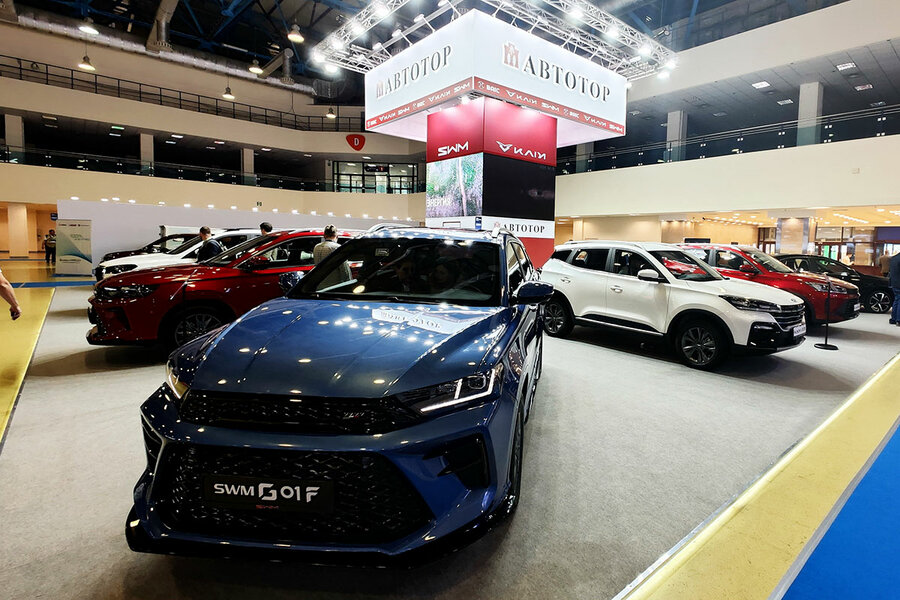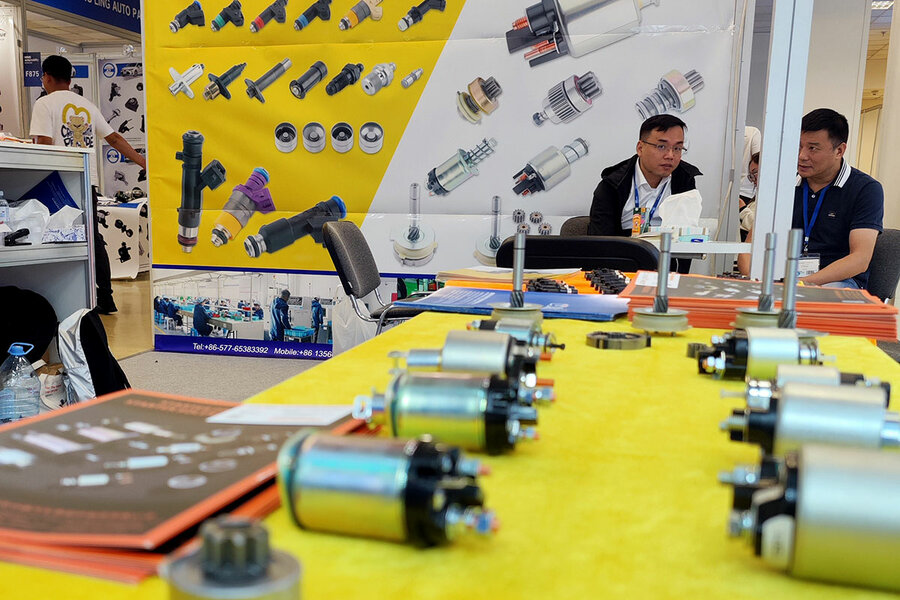Chinese, Iranian automakers woo Russians after Western brands leave
Loading...
| Moscow
When Russia’s war against Ukraine began last year, virtually all Western automakers pulled out of the country. Domestic new car sales plunged by 60% within months, and even production of Russia’s own homegrown brands, such as the iconic Lada, nearly ground to a halt.
Now, Russia’s auto industry has been transformed. Sales of new cars have rebounded this year (though they are still below prewar levels), and new foreign automakers from China and Iran have stepped in to fill the void left by the departing brands.
Why We Wrote This
A story focused onThe auto market is one of the few areas in Russia where Western sanctions had an immediate effect. Today, Russia’s car industry has been transformed, with new players, foreign and domestic, stepping to the fore.
Amir Kianmanesh, an Iranian executive, says his company’s new sedan will be an attractive option for Russian consumers. “Iran has been under sanctions for 30 years, and we’ve learned how to cope with it,” he says. “The Russians may have localized assembly, but not the whole production chain as we have.”
Everyone agrees that the biggest winner in Russia’s automotive revival is China. Chinese cars currently account for about half of all new car sales in Russia, and experts say their popularity is rising.
“Our best prospect right now is to bring large-scale production of Chinese models here, to restore our industry and market,” says Yevgeny Yeskov, editor of a Russian online car review site. “We need the Chinese.”
Just a few years ago, the MIMS annual trade fair for Russia’s auto industry was dominated by European, Japanese, and Korean automakers. Nissan, Hyundai, BMW, Volkswagen, Renault, and Mercedes were by far the most popular foreign brands, with many of their products assembled in Russian factories.
But a whole new cast of market players was on full display at the 27th annual edition of MIMS, held at a vast riverside exhibition complex in August.
When Russia’s war against Ukraine began last year, virtually all Western automakers pulled out of the country, abandoning their investments, closing dealerships, and shredding the warranties for millions of Russian car owners. Domestic new car sales plunged by 60% within months, and even production of Russia’s own homegrown brands, such as the iconic Lada, nearly ground to a halt amid critical shortages of imported parts.
Why We Wrote This
A story focused onThe auto market is one of the few areas in Russia where Western sanctions had an immediate effect. Today, Russia’s car industry has been transformed, with new players, foreign and domestic, stepping to the fore.
But exhibition organizers say this year’s event was bigger than ever, with the places of Western companies now taken by scores of Chinese providers of auto parts and services, and a totally new presence of Iranian, Turkish, and Indian producers. The Russian manufacturer Avtotor, which formerly assembled BMWs and Kias at its plant in the Baltic region of Kaliningrad, showed off a range of Chinese models it will now be producing, while two Iranian carmakers – who have been overcoming sanctions for decades – announced plans to debut their products on the Russian market.
“The show remains, the geography has changed,” says Anna Manvelova, director of the exhibition. “This is a very difficult time for the Russian automotive industry, which was one of the most damaged due to sanctions. But a crisis is also a time of opportunity.”
An enthusiastic but embattled market
Back in Soviet times, Russia produced a full range of domestic vehicles, though Soviet cars were never comparable in quality to Western counterparts, nor produced in quantities nearly enough to satisfy consumer demand. The average Soviet citizen typically waited years to take delivery of a small Zhiguli – based on a Fiat design – while the more substantial Volga sedan was mainly reserved for official use.
So after the collapse of the Soviet Union, Russians embraced automobile culture with great passion, including domestic models.
“Russian cars have always dominated the market,” says Ms. Manvelova. “In a rich city like Moscow, you might not see many Russian cars, but go out to any small town and that’s all you will see. The Lada is not only the current No. 1 on the market, it always was.”
But while Western sanctions over the Ukraine war didn’t bite much in most areas of everyday life, Russians felt them pretty quickly when it came to maintaining a car or trying to buy a new one.
Prices of parts and servicing shot up, while many buyers had to settle for a used car. Top-end Western models were still available, but had to be brought in by semi-smuggling methods known as “parallel import“ and came at much higher prices and without standard warranties. Russian automobiles have always been rather basic by Western standards, lacking automatic transmissions. But now due to parts shortages they are also being produced without power brakes, airbags, and other amenities.
“The situation remains bad, with the price of a new car being about the same as a new [apartment],” says Vladimir Zinin, financial director of a major car dealers association. Russia’s network of car dealerships is still struggling, he says, and without them an orderly relationship between consumers, producers, and banks remains difficult.
Still, sales of new cars have rebounded this year though they are still below prewar levels. According to the Autostat news service there were about 50 million passenger cars on Russian roads at the beginning of this year, less than half of which were foreign models.
“At least we no longer fear that we’ll have to exchange our cars for horses and buggies, which is how things looked a year ago,” says Mr. Zinin.
“All kinds of new people”
Most participants in this year’s MIMS auto fair were traditional Russian companies, who are reeling from the impact of sanctions and urgently seeking means of import substitution or new foreign partners. The exhibition was a prime venue for finding new clients, replacement suppliers, or filling market niches vacated by Western firms. “There is a big vacuum, and it’s being filled by all kinds of new people,” Ms. Manvelova says.
But the switchover is not without rough spots, especially when it comes to switching to new, unfamiliar models.
Efforts to convince taxi services to switch to Russian makes instead of the cheap Korean cars they have used in the past have hit serious roadblocks. The daily Noviye Izvestia quoted the owner of a taxi company as saying there had been nothing but trouble with a couple dozen Lada Granta cars that he bought. They started to break down after 40,000 km (25,000 miles), had weak electronics, and their radiators constantly overheated. The only advantage of the Russian cars, he told the paper, was cheap spare parts.
Last year the Moscow city government took over the sprawling Renault plant after the French carmaker pulled out of Russia. The same factory had formerly produced a Soviet compact car called the Moskvich, and Moscow’s mayor Sergei Sobyanin has pledged to reintroduce the brand in a modern all-Russian model, as a symbol of national resilience.
But the cars the factory has been producing are actually “re-badged” Chinese models, a fact that seems to underscore the deep complexities involved in fulfilling the Kremlin’s wish to recreate an indigenous Russian automobile industry.
Amir Kianmanesh, an executive of the Iranian automaker IKCO, says the Tara sedan, which his company has just begun introducing to the Russian market, will be an attractive option for consumers. He insists it’s price competitive with the Lada, but has many more advanced features that make it comparable to Western cars.
“Iran has been under sanctions for 30 years, and we’ve learned how to cope with it,” he says. “The Tara is 80% domestic production, with just a few imported parts. The Russians may have localized assembly, but not the whole production chain as we have. They have a long way to go.”
Everyone agrees that the biggest winner in Russia’s automotive revival is China. Chinese cars, particularly electric vehicles, have been making impressive inroads in global markets in general. They currently account for about half of all new car sales in Russia, and experts say their popularity is rising.
Chinese companies bring the same advantages that Western ones formerly did, including warranties and reliable servicing, experts say. But a survey conducted among Russian drivers by the industry group Otkritie Avto found that 44% complained about the cars’ thin metal skin, poor electronics and paintwork, and unsuitability for Russian roads.
“You can’t design new models from scratch, it’s too time consuming and expensive,” says Yevgeny Yeskov, editor of the online magazine AvtoBusinessReview. “Our best prospect right now is to bring large-scale production of Chinese models here, to restore our industry and market. We need the Chinese.”









